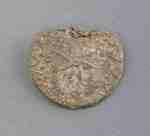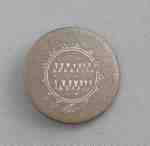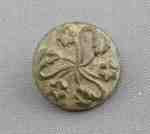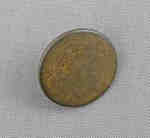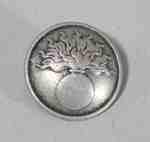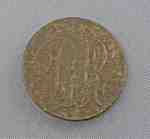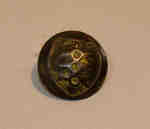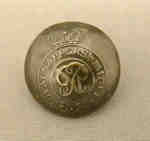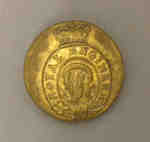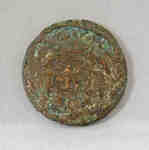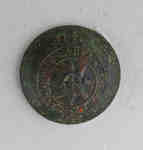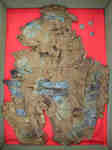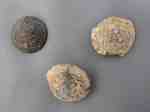Results
- This is a civilian button believed to be from the time of the War of 1812. The design on the face is a thin line star with ornate markings around the edges.This is a civilian button believed to be from the time of …
- This is a civilian button believed to be from the time of the War of 1812. The design on the face is a circle with circles periodically around the outside and lined triangles in the center.This is a civilian button believed to be from the time of …
- This is a civilian button believed to be from the time of the War of 1812. The design on the face includes curved lines from the center that reaches the edge with a leaf or star. On the back there isThis is a civilian button believed to be from the time of …
- A plain button, believed to be from the 1812 era, that has “Stand(D) Gold Col(R)” inscribed on the reverse.A plain button, believed to be from the 1812 era, that has …
- This regiment was formed in 1758 and was amalgamated into The Hampshire Regiment in 1881.This regiment was formed in 1758 and was amalgamated into The Hampshire …
- This is a domed pewter button with a fusilier grenade in relief.This is a domed pewter button with a fusilier grenade in relief.
- Button has letters R.R intertwined with no shank on the reverse. Diameter is 1.5 cm.Button has letters R.R intertwined with no shank on the reverse. Diameter …
- t has “70” raised in the centre surrounded by a raised laurel wreath. “SURRY” is also raised across the top of the button. This regiment was raised in 1782 and sailed from Cork, Ireland to Lower Canat has “70” raised in the centre surrounded by a raised laurel …
- A button of the 70th Surry Regiment that is 1.9 cm in diameter. It has “70” raised in the centre surrounded by a raised laurel wreath. “SURRY” is also raised across the top of the button. This regimeA button of the 70th Surry Regiment that is 1.9 cm in …
- This brass button was likely worn by a member of the Royal Artillery, as it features their crest.This brass button was likely worn by a member of the Royal …
- This button likely belonged to a member of the Royal Sappers and Miners. The button was produced by button maker, McGowan of London. The button was dug up at Fort George.This button likely belonged to a member of the Royal Sappers and …
- This is a British military button for "Royal Engineers".This is a British military button for "Royal Engineers".
- This is a brass button of the 49th Regiment (Hertfordshire) of the British army. Although the button has some corrosion there is a cipher with the number 49. There were two sizes of buttons worn by tThis is a brass button of the 49th Regiment (Hertfordshire) of the …
- Button has three raised cannon balls in a horizontal row across the top and three raised cannons in a vertical row that are set in a shield. It is believed that this button is from the War of 1812. DButton has three raised cannon balls in a horizontal row across the …
- Has a raised crown on the top and a raised 93 below. This button, believed to be from the 1812 era, is slightly corroded around the outside edge. The diameter is 1.4 cm.Has a raised crown on the top and a raised 93 below. …
- This is a cloth fragment of a uniform worn by a soldier of the 89th Regiment at the Battle of Lundy’s Lane. It was discovered in a trench on Lundy’s Lane on Sept. 3, 1891. There are also three regimeThis is a cloth fragment of a uniform worn by a soldier …
- A British infantry regiment that was raised in 1751 and amalgamated with the 52nd (Oxfordshire) Regiment of Foot, to form the Oxfordshire and Buckinghamshire Light Infantry in 1881. It is believed thA British infantry regiment that was raised in 1751 and amalgamated with …
- Accession Numbers: 986.D.098.052 986.D.098.053 986.D.098.054 986.D.098.055 986.D.098.056Accession Numbers: 986.D.098.052 986.D.098.053 986.D.098.054 986.D.098.055 986.D.098.056
- This button likely belonged to a member of the 100th Regiment. This regiment, also known as the Prince Regiment of Dublin County, which was raised in 1805. With few exceptions, all the officers and mThis button likely belonged to a member of the 100th Regiment. This …
When selecting an individual record or object, you will move
to the website of the heritage institution that houses the item.
To return to the search or results pages, select "Back", "Results" or "New Search".
 This project was made possible with the support of the Department of Canadian Heritage
This project was made possible with the support of the Department of Canadian Heritage
through the Canadian Culture Online Strategy.
to the website of the heritage institution that houses the item.
To return to the search or results pages, select "Back", "Results" or "New Search".
 This project was made possible with the support of the Department of Canadian Heritage
This project was made possible with the support of the Department of Canadian Heritage through the Canadian Culture Online Strategy.






